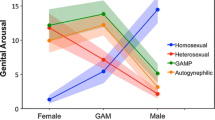Abstract
Since the beginning of the last century, clinical observers have described the propensity of certain males to be erotically aroused by the thought or image of themselves as women. Because there was no specific term to denote this phenomenon, clinicians’ references to it were generally oblique or periphrastic. The closest available word was transvestism. The definition of transvestism accepted by the end of the twentieth century, however, did not just fail to capture the wide range of erotically arousing cross-gender behaviors and fantasies in which women’s garments per seplay a small role or none at all; it actually directed attention away from them. The absence of an adequate terminology became acute in the writer’s research on the taxonomy of gender identity disorders in biological males. This had suggested that heterosexual, asexual, and bisexual transsexuals are more similar to each other—and to transvestites—than any of them is to the homosexual type, and that the common feature in transvestites and the three types of non-homosexual transsexuals is a history of erotic arousal in association with the thought or image of themselves as women. At the same time, the writer was becoming aware of male patients who are sexually aroused only by the idea of having a woman’s body and not at all by the idea of wearing women’s clothes. To fill this terminological and conceptual gap, the writer introduced the term autogynephilia(love of oneself as a woman).
Similar content being viewed by others
References
American Psychiatric Association. (2000). Diagnostic and statistical manual of mental disorders (4th ed., text revision). Washington, DC: Author.
Bailey, J. M. (2003). The man who would be queen: The science of gender-bending and transsexualism. Washington, DC: Joseph Henry Press.
Blanchard, R. (1985). Typology of male-to-female transsexualism. Archives of Sexual Behavior, 14, 247–261.
Blanchard, R. (1988). Nonhomosexual gender dysphoria. Journal of Sex Research, 24, 188–193.
Blanchard, R. (1989a). The classification and labeling of nonhomosexual gender dysphorias. Archives of Sexual Behavior, 18, 315–334.
Blanchard, R. (1989b). The concept of autogynephilia and the typology of male gender dysphoria. Journal of Nervous and Mental Disease, 177, 616–623.
Blanchard, R. (1990). Gender identity disorders in adult men. In R. Blanchard & B. W. Steiner (Eds.), Clinical management of gender identity disorders in children and adults (pp. 47–76). Washington, DC: American Psychiatric Press.
Blanchard, R. (1991). Clinical observations and systematic studies of autogynephilia. Journal of Sex and Marital Therapy, 17, 235–251.
Blanchard, R. (1992). Nonmonotonic relation of autogynephilia and heterosexual attraction. Journal of Abnormal Psychology, 101, 271–276.
Blanchard, R. (1993a). Partial versus complete autogynephilia and gender dysphoria. Journal of Sex and Marital Therapy, 19, 301–307.
Blanchard, R. (1993b). The she-male phenomenon and the concept of partial autogynephilia. Journal of Sex and Marital Therapy, 19, 69–76.
Blanchard, R. (1993c). Varieties of autogynephilia and their relationship to gender dysphoria. Archives of Sexual Behavior, 22, 241–251.
Blanchard, R., & Clemmensen, L. H. (1988). A test of the DSM-III-R’s implicit assumption that fetishistic arousal and gender dysphoria are mutually exclusive. Journal of Sex Research, 25, 426–432.
Blanchard, R., Clemmensen, L. H., & Steiner, B. W. (1987). Heterosexual and homosexual gender dysphoria. Archives of Sexual Behavior, 16, 139–152.
Buckner, H. T. (1970). The transvestic career path. Psychiatry, 33, 381–389.
Buhrich, N. (1978). Motivation for cross-dressing in heterosexual transvestism. Acta Psychiatrica Scandinavica, 57, 145–152.
Ekins, R., & King, D. (2001). Transgendering, migrating and love of oneself as a woman: A contribution to a sociology of autogynephilia. International Journal of Transgenderism, 5. Retrieved August 1, 2004 from http://www.symposion.com/ijt/ijtvo05no03_01.htm
Ellis, H. (1928). Studies in the psychology of sex (Vol. 7). Philadelphia: F. A. Davis.
Ellis, H. (1935). Psychology of sex: A manual for students. New York: Emerson Books.
Fenichel, O. (1930). The psychology of transvestism. International Journal of Psycho-Analysis, 11, 211–227.
Freund, K., & Blanchard, R. (1993). Erotic target location errors in male gender dysphorics, paedophiles, and fetishists. British Journal of Psychiatry, 162, 558–563.
Freund, K., Steiner, B. W., & Chan, S. (1982). Two types of cross-gender identity. Archives of Sexual Behavior, 11, 49–63.
Henry, G. W. (1948). Sex variants: A study of homosexual patterns. New York: Hoeber.
Hirschfeld, M. (1910). Die Transvestiten [Transvestites] (1st ed.). Berlin: Alfred Pulvermacher.
Hirschfeld, M. (1918). Sexualpathologie [Sexual pathology] (Vol. 2). Bonn: Marcus & Weber.
Hirschfeld, M. (1925). Die Transvestiten [Transvestites] (2nd ed.). Leipzig: Ferdinand Spohr.
Hirschfeld, M. (1948). Sexual anomalies. New York: Emerson Books.
Hirschfeld, M. (1991). Transvestites (M. A. Lombardi-Nash, Trans.). Buffalo, NY: Prometheus Books. (Original work published 1910)
Karpman, B. (1947). Dream life in a case of transvestism with particular attention to the problem of latent homosexuality. Journal of Nervous and Mental Disease, 106, 292–337.
Lawrence, A. A. (1999a). 28 narratives about autogynephilia. Retrieved July 23, 2004, from http://www.annelawrence.com/agnarratives.html
Lawrence, A. A. (1999b). 31 new narratives about autogynephilia. Retrieved July 23, 2004, from http://www.annelawrence.com/31narratives.html
Lawrence, A. A. (1999c). Autogynephilia: Frequently-asked questions. Retrieved July 28, 2004, from http://www.annelawrence.com/agfaqs.html#5
Lawrence, A. A. (2004). Autogynephilia: A paraphilic model of gender identity disorder. Journal of Gay and Lesbian Psychotherapy, 8, 69–87.
Zucker, K. J., & Blanchard, R. (1997). Transvestic fetishism: Psychopathology and theory. In D. R. Laws & W. O’Donohue (Eds.), Sexual deviance: Theory, assessment, and treatment (pp. 253–279). New York: Guilford.
Author information
Authors and Affiliations
Corresponding author
Rights and permissions
About this article
Cite this article
Blanchard, R. Early History of the Concept of Autogynephilia. Arch Sex Behav 34, 439–446 (2005). https://doi.org/10.1007/s10508-005-4343-8
Issue Date:
DOI: https://doi.org/10.1007/s10508-005-4343-8




